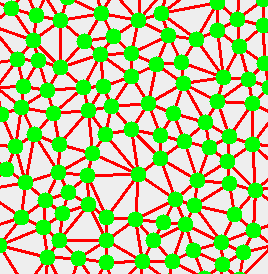Delaunay simplexes: Difference between revisions
Jump to navigation
Jump to search
Carl McBride (talk | contribs) No edit summary |
(Some mor info on these nice structures, plus link to CGAL) |
||
| Line 1: | Line 1: | ||
[[Image:Delaunay.png|thumb|An example of Delaunay triangulation in two-dimensions]] | [[Image:Delaunay.png|thumb|An example of Delaunay triangulation in two-dimensions]] | ||
A '''Delaunay simplex''' is the dual of the [[Voronoi cells |Voronoi diagram]]. Delaunay simplexes were developed by Борис Николаевич Делоне. In two-dimensions <math>({\mathbb R}^2)</math> it is more commonly known as ''Delaunay triangulation'', and in three-dimensions <math>({\mathbb R}^3)</math>, as ''Delaunay tetrahedralisation''. | A '''Delaunay simplex''' is the dual of the [[Voronoi cells |Voronoi diagram]]. Delaunay simplexes were developed by Борис Николаевич Делоне. In two-dimensions <math>({\mathbb R}^2)</math> it is more commonly known as ''Delaunay triangulation'', and in three-dimensions <math>({\mathbb R}^3)</math>, as ''Delaunay tetrahedralisation''. | ||
The Delaunay triangulation fulfills the '''empty circle property''': | |||
the circumscribing circle of each facet of such a triangulation does not contain any other vertex of the triangulation in its interior (a similar property holds for the tetrahedralisation). | |||
==References== | ==References== | ||
#Математические основы структурного анализа кристаллов (совместно с А.Д.Александровым и Н.Падуровым), Москва, Матем. литература, 1934 г. | #Математические основы структурного анализа кристаллов (совместно с А.Д.Александровым и Н.Падуровым), Москва, Матем. литература, 1934 г. | ||
==External links== | |||
#[http://www.cgal.org/ The CGAL project on computational geometry] | |||
Revision as of 16:14, 12 September 2007

A Delaunay simplex is the dual of the Voronoi diagram. Delaunay simplexes were developed by Борис Николаевич Делоне. In two-dimensions it is more commonly known as Delaunay triangulation, and in three-dimensions , as Delaunay tetrahedralisation.
The Delaunay triangulation fulfills the empty circle property: the circumscribing circle of each facet of such a triangulation does not contain any other vertex of the triangulation in its interior (a similar property holds for the tetrahedralisation).
References
- Математические основы структурного анализа кристаллов (совместно с А.Д.Александровым и Н.Падуровым), Москва, Матем. литература, 1934 г.

